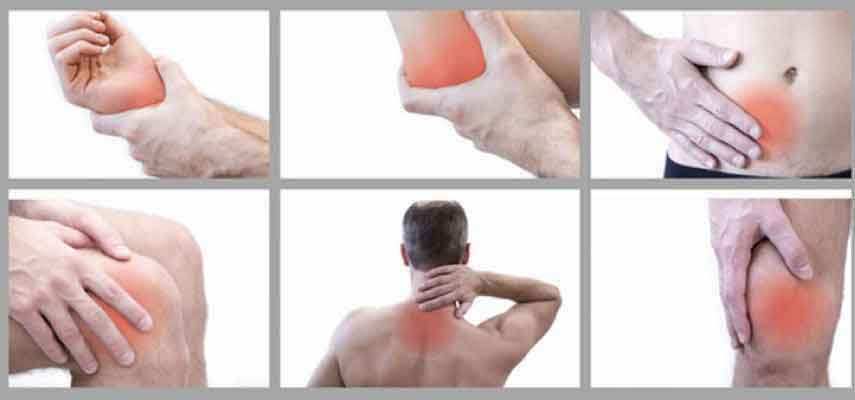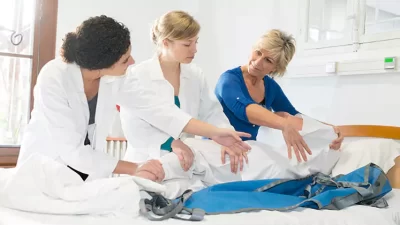Joints are the connections between bones which provide support and allow movement. Any damage to the joints can cause joint pain. This includes joint damage from injury or disease which can get in the way of movement and cause pain in the affected area. There are many different conditions that can cause painful joints. According to a recent survey, about 33% or one-third of adults reported experiencing joint pain within the last 30 days. Knee pain was the most common followed by shoulder then hip pain. Joint pain can affect any part of the body from the shoulders to the ankles. The problem becomes more common as a person gets older.
Joint pain ranges from mild discomfort to debilitating pain. It may be acute (lasting a few weeks) or chronic (lasting several weeks or months). The problem is that even short-term pain of the joints like in the case of an ankle injury can considerably affect a person’s quality of life. The best treatment depends on the particular cause of the joint pain thus the importance of an accurate diagnosis. In this article, we will be taking a close look at common joint pain conditions or causes of joint pain.
Chronic Pain
Chronic pain is any kind of pain that lasts more than 6 months. It can range from mild to excruciating and may be continuous or episodic. The most common sources of pain involve headaches, joint pain, and backaches. The treatment usually involves addressing both psychological and physical causes of pain.
Bone Tenderness
Bone pain or tenderness is a common problem among aging individuals. It is mostly due to the natural decrease in bone density as a person gets older. Bone tenderness can also be due to an injury or underlying medical condition. It is often experienced with some joint pain around the affected areas. The treatment depends on the specific cause of the pain which needs to be diagnosed by a physician.
Nerve Pain/Neuralgia

Nerve pain or neuralgia can be caused by inflammation, injury, compression and a number of diseases like arthritis which can also cause joint pain. There are several types of neuralgia depending on the specific cause. For instance, trauma like surgery and any type of inflammation can cause nerve pain which can affect the surrounding area including joints, muscles, and bones.
Spondyloarthropathies
Spondyloarthrithies are a group of chronic diseases that affect the joints. The diseases can occur in children but can also develop later on in life. They include Reiter’s syndrome (reactive arthritis), ankylosing spondylitis, psoriatic arthritis and other joint problems connected to enteropathic arthritis. There are different symptoms depending on the particular type but usually involve the attachments of the lower back to the pelvis or the sacroiliac joint. These diseases also affect the area surrounding the affected joint where the bone is attached to ligaments and tendons like the knee, hip, and foot. Take note that spondyloarthropathies are not the same as rheumatoid arthritis and juvenile idiopathic arthritis.
Muscle Aches
Muscle aches are usually caused by tension, overuse and minor injuries. The type of pain is commonly localized affecting one or more muscles in a particular area of the body. In many cases, the joints near the area are also affected causing joint pain. Systemic muscle pain or when muscle pain throughout the body is different which is typically due to an illness or infection.
Joint Tenderness

Joint tenderness can be due to an injury or disease. This is when pain is experienced when a particular joint is touched. Movement can also cause pain or discomfort that ranges from mild to excruciating. The treatment for injuries usually involves rest, physical therapy and medication (for controlling pain). For disease-related joint tenderness, treatment is mostly for maintaining joint mobility and preventing joint damage.
Stiff Joints
Having stiff joints typically in the morning is a hallmark of rheumatoid arthritis which is a chronic disease that affects more than a million adult Americans. It involves the inflammation of soft tissue lining the surface of the joints (synovium). The disease is systemic and makes the joints stiff and painful but later on can affect other parts of the body like the internal organs. Living a more active lifestyle and exercising helps in slowing down the progress of the disease and reduces stiff joints.
Charcot Joint
Charcot joints which are often called neuropathic joints are a result of the loss of sensation in the joint. It is caused by severe damage and disruption which can be diagnosed using clinical examination and an X-ray. It often involves joint injury but can also be caused by autonomic neuropathy, mismatch of bone destruction and synthesis or poor blood supply.
Joint Swelling

Joint swelling can either be from injury or diseases (like rheumatoid arthritis). To reduce swelling, applying an ice pack in the affected area is often the first method for treatment. For severe cases, medication may be necessary to help subside joint swelling quickly.
Joint Redness
Joint redness is simply the appearance of redness on the skin located above a joint. It can be caused by a number of medical conditions like septic arthritis, gout, cellulitis, rheumatic fever, etc.
Hip Bursitis
This is a common cause of joint pain that affects the small, fluid-filled sacs (bursae) which cushions the bones, tendons and muscles around the joints in the hips. It occurs when the bursae become inflamed due to repetitive motion. Aside from the hips, it also often occurs in the shoulder and elbow. The treatment primarily involves rest and protecting the affected area from further trauma. In most cases, bursitis pain subsides in a few weeks with proper treatment. However, recurrent flare-ups commonly occur in many cases.
Tendinitis
This is an inflammation or irritation of a particular tendon which usually occurs from wear and tear. It can occur in any part of the body but is common in the shoulders, elbows, knees, wrists, and heels. Some common names of tendinitis problems are pitcher’s shoulders, golfer’s elbow, tennis elbow and swimmer’s shoulder. If the problem becomes severe, the rupture of a tendon can occur which may require surgical repair. In most cases, it can be treated with a combination of rest, medication (for reducing pain) and physical therapy.
Osteomyelitis

This is an infection in the bone which was once known to be an incurable condition. Infections can reach bone through the bloodstream or from nearby tissue. It can also begin in the bone if it is exposed to germs through an injury. It usually affects long bones in children and bones that make up the spine in adults. People with diabetes may develop osteomyelitis if they have a foot ulcer. Parts of the bone that have died may require surgery for removal followed by strong antibiotics.
Dislocation
Dislocations are injuries specific to joints wherein the ends of the bones are forced from their normal positions. This is a very painful injury that may involve temporary deformity and immobilization of the joint. It commonly occurs in the shoulders and fingers. This type of injury requires immediate medical attention to return the bones in their normal positions. With proper treatment, most dislocations return to normal function in several weeks. However, certain joints like the shoulders typically have an increased risk of re-dislocation.
Fibromyalgia
This is a disorder characterized by moderate to severe musculoskeletal pain along with other symptoms like fatigue, mood problems, and memory issues. According to experts, the disorder amplifies pain by affecting the way the brain processes pain signals. The symptoms usually begin after physical trauma, surgery or infection but in some cases accumulate over time with no specific triggering event. Women are more likely to develop fibromyalgia which is usually accompanied by tension headaches, anxiety, irritable bowel syndrome, and depression. There is no cure for this disorder but medications are available for controlling symptoms.
Rickets
Rickets is a disease in children which causes softer than normal bones. It results in muscle and bone weakness and deformity. The most common cause is a lack of vitamin D but can also be due to deficient calcium levels. In most cases, it is because of a genetic disorder that negatively affects vitamin D absorption.
Pseudogout

This is a specific form of arthritis characterized by a sudden and painful swelling of one or more joints. The episodes can last for a few days or weeks. It commonly affects the knees caused by crystal deposits within the joint. The specific type of crystal deposit is different from those in gout. It is still not clear why crystals form in the joints but the risk increases with age. Treatments are primarily for relieving pain and reducing inflammation.
Osteomalacia
Osteomalacia is very similar to Rickets. It is the softening of the bones usually from vitamin D deficiency. It is a result of a defect in the body’s process of building bones making the bones softer and more likely to bow and fracture compared to normal bones.
Hypothyroidism
Hypothyroidism is having an underactive thyroid resulting to lower than normal production of thyroid hormones. It causes excess body fat, fatigue, joint pain and a number of other symptoms. The symptoms differ slightly from one case to another. Older women are more likely to suffer from hypothyroidism.
Scoliosis
Scoliosis is an abnormal curvature of the spine (toward the side). It can be congenital or caused by an abnormality in the formation of bone that is present during birth but can also be a result of abnormal muscles or nerves (neuromuscular scoliosis). Injury or illness (degenerative scoliosis) can also cause a problem. The most common type is idiopathic scoliosis wherein there is no identifiable cause.
Sciatica
Sciatica is a term used to describe the symptoms of leg pain which may include a tingling sensation, weakness or numbness originating from the lower back traveling through the buttock down to the sciatic nerve in the back portion of the leg. It usually causes a sharp pain that makes it difficult to stand up, walk or run.
Migratory Arthritis
Migratory arthritis occurs when the pain spreads from a particular joint to another. As the pain transfers to the next joint, the pain in the initial joint may start to subside. It is usually a result of a serious illness but can also be experienced by people suffering from other forms of arthritis.
Herniated Disc
A herniated disk refers to a problem in one of the rubbery cushions (called disks) between individual bones (vertebrae) stacking up to make the spine. It is often called a slipped or ruptured disk. It can irritate nerves in the area causing pain, weakness or numbness that moves towards an arm or leg. In many cases, people don’t experience symptoms so surgery is not needed but in cases where the pain is unbearable, surgery and/or medication may be necessary.
Degenerative Disc Disease
This is not really a disease but is actually a term used to describe the normal changes in the spinal discs as a person gets older. The disc acts like shock absorbers for the spine but normally deteriorates as a person gets older. It usually affects the lower back and neck causing pain in the affected area.
Cartilage Disorders
Cartilage disorders involve the abnormal deterioration of the articular cartilage where the ends of bones meet. The result is significant pain and weakness in the affected areas because of the friction caused when two bones rub against each other. Treatment involves filling in the defect with healthy articular cartilage through surgery to provide new protection for the surface of the joint.
Lupus Erythematosus

This is a chronic inflammatory disease that occurs when the immune system attacks the body’s tissues and organs including the joints. It can also affect the skin, blood cells, kidneys, heart, brain, and other body systems. This is a very difficult disease to diagnose because the signs and symptoms are similar to many ailments. Some people are predisposed to the development of lupus which may be triggered by certain drugs or infections. There is no cure for lupus and treatment is primarily for controlling symptoms.
Sprains And Strains
Sprains and strains are among the most common injuries that affect a lot of people. The two have very similar signs and symptoms but affect different parts of the body. Sprains involve stretching or tearing ligaments or the tough fibrous bands of tissue that connect bone to joints. It commonly occurs in the ankle. Strains involve stretching or tearing a muscle or tendon. Tendons are fibrous cords of tissue which connect bones to muscles. Strains usually occur in the lower back or in the hamstring muscle. Treating these injuries usually involves resting allowing the injury to heal itself.
Spondylolisthesis
This condition involves a bone in the back (vertebra) sliding forward over the bone below it. The condition usually occurs in the lower part of the spine and can lead to the spinal cord or nerve roots to become impinged. The result is back pain and/or numbness which can sometimes cause weakness in one or both legs. In some cases, bladder or bowel control can be affected as well.
Inflammatory Joint Effusion

This occurs when there is joint effusion with high WBC count and polymorphic neutrophil percentage in the fluid. There are several possible causes including gout, rheumatoid arthritis, pseudogout, and other conditions. It may also assist in joint pain inflammation relief to severe pain in the affected areas.
Non-Inflammatory Joint Effusion
Non-inflammatory joint effusion is when there is joint effusion but the fluid in the joints is transparent or straw-colored and the WBC count and polymorphic neutrophil percentage is normal. The treatment for this type of joint effusion is different from the inflammatory type so an accurate diagnosis is important.
Haemorrhagic Joint Effusion
Haemorrhagic joint effusion occurs when there is joint effusion consisting of frank blood. There are several possible causes including trauma, bleeding disorders, neuropathic arthropathy, and synovioma.
Chondromalacia Patella
This is when the cartilage under the kneecap is damaged from injury or overuse. It causes pain in the affected area which usually increases when the patient walks up or downstairs. The treatment is usually rest and ice to subside swelling but surgery and/or physical therapy may be needed to ease the pain.
Repetitive Motion Injuries
These are tissue injuries from repeated motions which are the most common injuries in the United States. In fact, repetitive motion injuries make up more than 50% of athletic-related injuries in the country. It includes tendinitis and bursitis.
Complex Regional Pain Syndrome
This is a rare form of chronic pain that commonly affects a limb (arm or leg). It typically develops after injury, surgery, heart attack or stroke but the pain is a lot more severe compared to the initial injury. The actual cause of this condition is still unclear.
Heberden’s Nodes
This is a classic sign of hand osteoarthritis. Herberden’s nodes are bony enlargements of the joint nearest the fingertip or the DIP joint. It is usually painful and makes movement of the joint very difficult. Some studies suggest that there is a genetic predisposition to the development of the nodes.
Conclusion
There are many conditions that can cause joint pain. Aside from the conditions mentioned in this article, there are many others. The best treatment depends on the particular condition that causes joint pain which can be properly diagnosed by an experienced doctor or specialist. This is why if you are suffering from any type of joint pain, it would be best to consult your physician.







 This article changed my life!
This article changed my life! This article was informative.
This article was informative. I have a medical question.
I have a medical question.
 This article contains incorrect information.
This article contains incorrect information. This article doesn’t have the information I’m looking for.
This article doesn’t have the information I’m looking for.